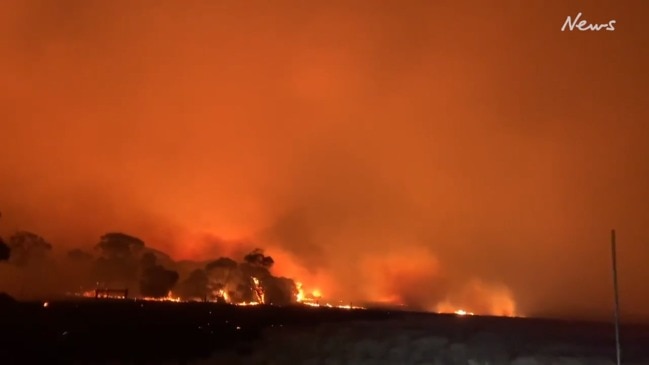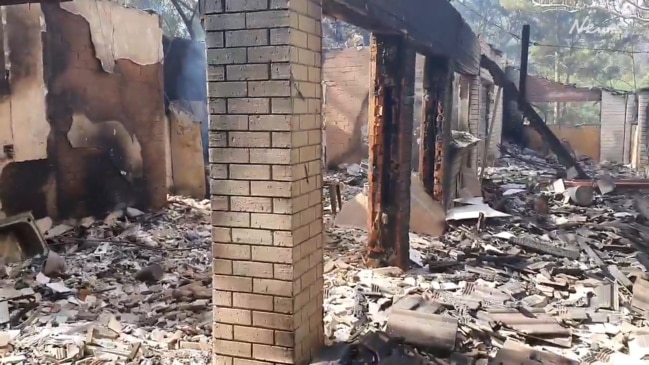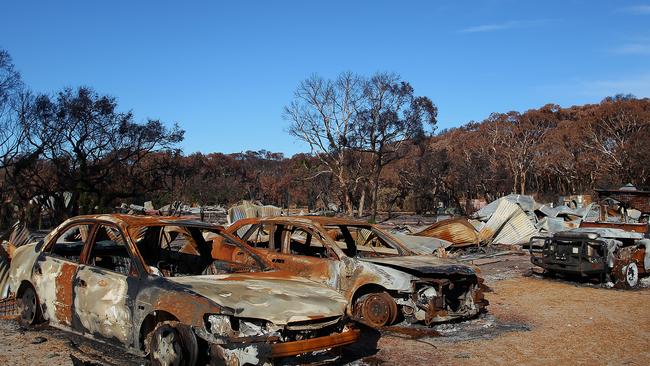Findings of review into SA’s summer bushfires released and details 15 recommendations
A review into South Australia’s devastating summer bushfires has been released – 15 recommendations have been made in the hope we will never experience another horror season.

SA News
Don't miss out on the headlines from SA News. Followed categories will be added to My News.
- KI marks major milestone after devastating bushfires
- The SA town fighting back from forgotten inferno
- Hills community counts cost of devastating Cudlee Creek fire
Installing technology that can pinpoint the location of firetrucks, removing stamp duty from home insurance and improving the way public warnings are communicated are among 15 recommendations outlined in an independent review into South Australia’s 2019/20 bushfire season.
The State Government released the report on Sunday and committed $20.3 million towards several initiatives discussed in the review.
This includes rolling out 25 new firetrucks; providing thermal imaging cameras for each CFS group; developing a lightning tracking system to help detect and respond to lightning ignitions; improving emergency warnings; and implementing a new State Bushfire Management Plan before the start of the upcoming bushfire season in November.
It will also trial an Automatic Vehicle Location system, which tracks the location of firetrucks, over summer.

The Government will further consider the remaining recommendations.
Another $16.7 million in Federal and State Government funding will be invested over five years into the South Australian Disaster Risk Reduction Grants Program while a further $11.5 million will go to the MFS for new urban appliances.
The review was led by former Australian Federal Police Commissioner Mick Keelty and examined the most recent bushfire season – considered one of the worst in the state’s history.
About 280,000ha of land was burnt and 68,000 livestock perished and $200 million worth of agricultural production was lost.

The review – which acknowledged that loss of life and property “could have been far more severe” and praised the efforts of the emergency services – identified a number of issues encountered during the season, including inadequate planning to protect critical assets such as mobile phone towers.
“Some firefighters said they were only tasked to ‘fight the fires’ and relied on local knowledge about what assets needed to be protected,” the report read.
It was also critical of how information was shared between Incident Management Teams and the State Emergency Centre.
“The review heard that records from the CFS’s CRIIMSON database had to be manually extracted and uploaded so that SAPOL, SES and other agencies could receive and consider that information,” it read.
“This is a totally unacceptable situation and needs urgent investment and improvement.”

The review also found volunteer training and equipment needed to be improved, noting some brigades were working with ageing vehicle fleets.
It further stated the dissemination of public information about incidents should be sped up.
“The ability to know where the fires are and where they are going is difficult to obtain as are rapid damage assessment, which were considered too slow,” the report read.
“It is a critical area for improvement because social media will outpace information being processed through bureaucratic procedures and people will make their own decisions before authorities have time for consider the issues.
“A single endorsed social media platform needs to be implemented as well.”
Among recommendations, the report urged the Government to implement findings from previous reviews, considers removing stamp duty from home insurance to encourage more people to take it out, and instigate better co-ordinated public information and warnings.
It also suggested either the SAFECOM board be abolished or it appoints an independent chair.
At present, the organisation’s chief executive preside over the board.

Emergency Services Minister Corey Wingard said the Government would seek to amend legislation to appoint an independent chair to the board.
“We will also commence consultation with all our volunteers and emergency services personnel on how SAFECOM as a department could be structured,” he said.
“As a government, we’re committed to addressing these critical recommendations because there’s no point in requesting a report only to leave it sitting in a drawer gathering dust.”
Premier Steven Marshall said it was important the implement changes as quickly as possible.
“It is vital that we take what we can from the trauma we have already lived through and apply any learnings for future bushfire seasons,” he said.
CFS chief officer Mark Jones welcomed the review’s findings.
“As with all emergency responses, there are lessons to be learned,” he said.
“We’ll take the finding from the Keelty review, we’ll blend them with our own findings from the lessons learned process and seek to improve going forward, firstly for the next season and then for every season afterwards.”
CFS Volunteers Association president Andy Wood said the organisation supports “the concept of an independent chair for SAFECOM and of course we fully support the AVL for (firetrucks)”.
Opposition emergency services spokesman Lee Odenwalder said he was “deeply concerned” proposed MFS firetruck upgrades would be spread over four years.
“We know that firefighters have identified the urgent need for these upgrades ahead of this years fire season, yet Corey Wingard has decided to delay the full rollout,” he said.
THE RECOMMENDATIONS:
IMPLEMENT previous review recommendations.
ALIGN risk assessment tools and processes
CONSIDER appointing an independent chair of the SAFECOM board, or abolish the board altogether
UPGRADE and integrate information and communications technology
EDUCATE the community about their roles and responsibilities in managing native vegetation
CONSIDER removing stamp duty from home insurance
PREPARE to “scale up” capability during major bushfire events
ENGAGE with the Australian Defence Force once or twice a year to understand their capabilities and educate Incident Management Teams about how to deploy ADF assistance effectively
INVEST in technology such as automatic vehicle location systems, thermal imagery, burnover protection systems and lightning tracking.
INCLUDE farm firefighting units in the Australasian Inter Service Incident Management System so authorities are aware of their presence on the fireground.
DEVELOP and practice procedures for CFS, Environment and Water Department staff and councils to access and deploy heavy plant and machinery for fuel reduction operation before and during bushfires.
REVIEW the use of water bombers and their facilities.
BETTER co-ordinate public information and warnings.
CLARIFY business continuity and restoration of critical infrastructure in the planning and response phases.
COLLATE data and research the impact of bushfires upon communities , firefighters and animals to identify medium and long-term support requirements.
THE 2019/20 BUSHFIRE SEASON AT A GLANCE:
A total of 278,838ha were burnt during bushfires in the Adelaide Hills, on Kangaroo Island, the Yorke Peninsula, in Port Lincoln and the southeast during the 2019/20 bushfire season.
Three people died in the fires and 196 homes were destroyed and 660 vehicles were lost or damaged.
Almost 68,000 livestock perished in the blazes.
However, emergency services saved more than 1310 properties in what the review has described as the worst bushfire conditions in the state’s history.
The most affected industries were wine, tourism, honey, farming, forestry and aquaculture.
Agriculture lost $186.57 million worth of production.
Up to 50,000 koalas were killed and more than 90,000ha across 17 national parks were burnt.
Adelaide Hills
When: December 2019
Hectares burnt: 23,253
Lives lost: 1
Homes destroyed: 98
Businesses, sheds, community facilities destroyed/damaged: 542
Vehicles destroyed/damaged: 325
Kangaroo Island
When: December 2019
Hectares burnt: 211,474
Lives lost: 2
Homes destroyed: 87
Businesses, sheds, community facilities destroyed/damaged: 332
Vehicles destroyed/damaged: 322
Yorke Peninsula (Yorketown)
When: November 2019
Hectares burnt: 6694
Lives lost: 0
Homes destroyed: 8
Businesses, sheds, community facilities destroyed/damaged: 11
Vehicles destroyed/damaged: 11
Port Lincoln (Duck Ponds)
When: November 2019
Hectares burnt: 235
Lives lost: 0
Homes destroyed: 2
Businesses, sheds, community facilities destroyed/damaged: 2
Vehicles destroyed/damaged: 2
South East (Keilira)
When: December 2019
Hectares burnt: 37,182
Lives lost: 0
Homes destroyed: 1
Businesses, shed, community facilities destroyed/damaged: 5
Vehicles destroyed/damaged: 0
Originally published as Findings of review into SA’s summer bushfires released and details 15 recommendations



